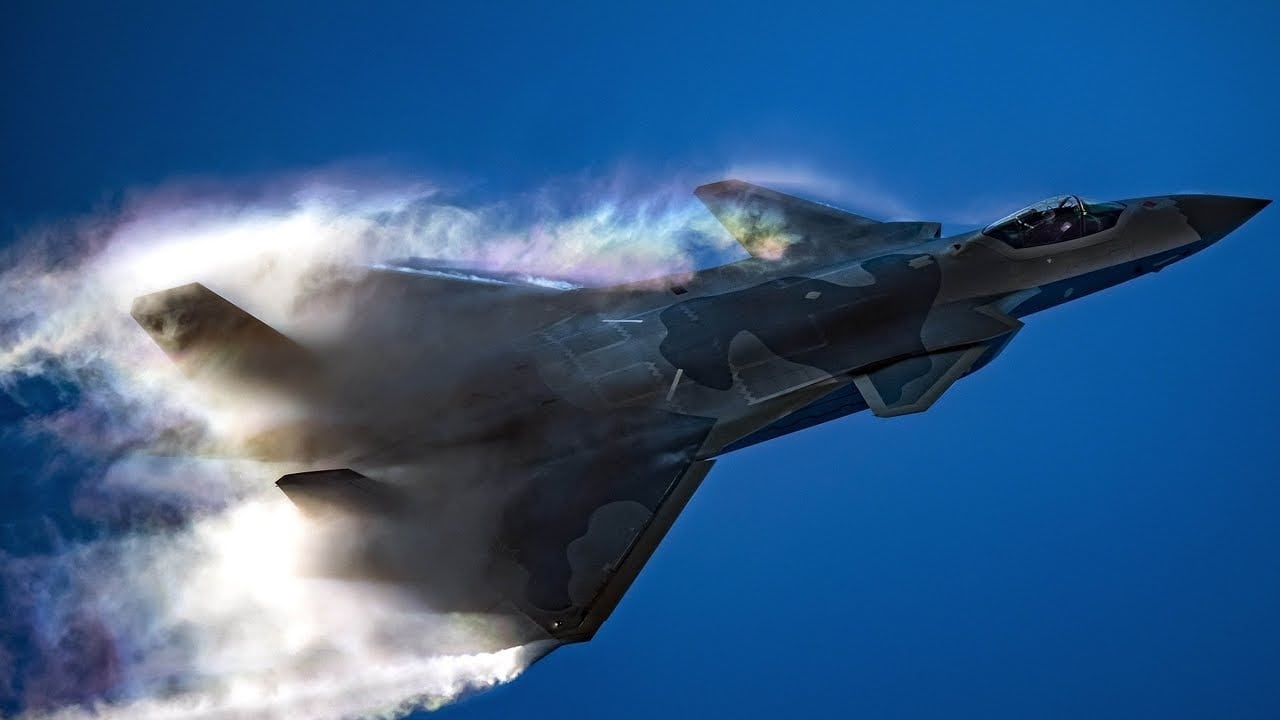Peter Suciu

China’s J-20 stealth fighter has been making the rounds on the internet for years now. How good is this fighter in actual combat operations? Could it say, for example, take on a U.S. stealth fighter like the F-22 or F-35 or something from Russia? The South China Morning Post reported this recently that China’s J-20 stealth aircraft has been “making regular patrols over the East and South China Seas.” It was the first official confirmation that the country’s most advanced warplane was operating over such a wide area.
In addition, the statement from the aircraft’s developer also touted that the fifth-generation fighter is now powered by newly developed, domestically-built engines. That could likely increase the capabilities of the aircraft, which had previously been powered by Russian-made Al-31F engines as well as the indigenously-produced WS-10B. Both those engines were designed for less advanced aircraft.
“The J-20 has switched to a ‘Chinese heart’ and it has become a training routine to conduct combat patrols in the East China Sea and alert patrols in the South China Sea,” Ren Yukun, a senior official from the state-owned Aviation Industry Corporation of China (AVIC), said during an April 12 press conference.
Efforts to produce a new engine, the WS-15, also came up short when it failed its final evaluation in 2019. As a result, engineers have been fitting the aircraft with the WS-10C, an upgraded version of the original WS-10.
How Many J-20s?
The People’s Liberation Army (PLA) has not disclosed the number of operational J-20s, but it is widely estimated that the number is around 150.
According to multiple sources, the Chengdu Aircraft Industry Group, the developer of the J-20 and a AVIC subsidiary, had set up a fourth production line in 2019 and began mass production of the aircraft in 2020. Each of the production lines reportedly has the capacity to make about one J-20 a month.
The People’s Republic of China (PRC) has long touted the capabilities of its Chengdu J-20 stealth fighter since it was first introduced in 2011. The fifth-generation superiority fighter, which descended from the J-XX program of the 1990s, entered service in March 2017 while the first J-20 combat unit was formed just shy of a year later.
The J-20, also known as the Mighty Dragon, is just the world’s third operational fifth-generation stealth fighter aircraft after the United States military’s F-22 Raptor and F-35 Lightning II Joint Strike Fighter.
U.S. Tech Involved?
China has long operated by the notion that good artists borrow, and great artists steal – and its theft of aviation technology unquestionably played a role in the development of the J-20.
The aircraft was almost certainly based on stolen designs from the United State Air Force’s Lockheed Martin F-22 Raptor. The appearance and profile of the aircraft are far from the only similarities between the two fifth-generation fighters.
It would be a tremendous coincidence that the J-20’s development began in earnest only after the F-22 was unveiled, yet some of the technology on the Chinese fighter has been described as looking “awfully similar” to systems on the Lockheed Martin F-35 Lightning II Joint Strike Fighter.
It would be suspicious enough if the Chinese fighter merely resembled the F-22, while the fact that its sensor system is so close in design to the Lockheed Martin Electro-Optical Targeting System found on the Lightning II surely suggests that espionage played some role in the Mighty Dragon’s development.
Chinese Hackers Involved
In 2007, Lockheed Martin found that Chinese hackers had been stealing technical documents related to the F-35 program, while a similar theft occurred when hackers working for Beijing breached a network of an Australian F-35 sub-contractor, the Asia Times reported.
Based on those breaches, it seems likely that the Chinese had acquired crucial information and technical data that has been utilized in the production of the J-20.
Despite the fact that China gained valuable insight from the west, which certainly aided in the development of its advanced aircraftit has also kept its cards close to the chest, revealing few details about the capability of the fifth-generation fighter.
It is believed the J-20 is capable of reaching a maximum speed close to Mach 2 (1,535 mph) and has a ceiling of around 60,000 feet along with a range of about 700 milesbut other key information is sparse.
No comments:
Post a Comment